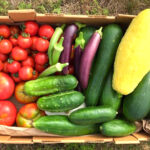The desert tortoise enclosure appears to be empty, but Tank, Mr. Peabody and Bad News Bernie are hiding from the noonday sun in their rather stylish little houses that resemble miniature stables.
“In the wild, the tortoises dig burrows to stay cool, but of course, they can’t do that here,” says our guide, Pam Meisner, who knows these guys well because in the winter, they brumate (a type of hibernation) in boxes in her closet.
These tortoises, while intriguing, are not the stars of the show here at the Water Conservation Garden on the campus of Cuyamaca College in El Cajon. They are the 6 acres of marvelous demonstration gardens and landscaping ideas designed to teach us mortals how to create lush front and back yards on a strict, water-saving diet, and to use natural resources sustainably.

For less than an hour’s drive from North County, visitors can learn how to landscape artistically using containers; use drought-tolerant plants; mulch and fertilize sustainably; capture and recycle water; create bird- and butterfly-friendly gardens; and if you must plant grass, choose the least water-sucking variety.
The other garden star is Meisner, aka Ms. Smarty-Plants. The Director of Operations and Programs has been with the garden for 14 of its 22 years and wears many hats — literally. The walls of her tiny office in the garden, which she and her brother built, are decorated with the themed hats that match her topic and audience. In 2019, Meisner inspired, educated and entertained more than 85,000 kids and adults who either visited the garden or were recipients of Meisner’s outreach programs.
In 2013, the Ms. Smarty-Plants program won the Governor of California’s Environmental Leadership Award.
The nonprofit garden is sustained by memberships, donations, the all-volunteer Friends of the Water Conservation Garden, and an independent, nonprofit board of directors.
Yes, you can come here just to enjoy the verdant ambiance created by the staff and more than 70 volunteers, but it’s difficult to escape without learning a lot.

For one thing, “we are not a desert,” Meisner says emphatically. “We are an arid Mediterranean climate. People want it to be tropical, though, but we are lucky if we get 5 inches of rain a year.”
Visitors also learn water-saving vocabulary — words like swale, xeriscape (not zeroscape!), water table, rain chain, permeable pavement, defensible space and worm tea. (That last thing makes the most excellent fertilizer.)
“Everything here demonstrates how to irrigate correctly, choose plants, mulch properly and use passive and active water-saving techniques,” Meisner says.
Pearls from Ms. Smarty-Plants:
• The hardest thing to understand is that you have to be patient when planting. Give plants room to grow into each other.
• You can prune any way you like. Prune trees to look like bushes and prune bushes to look like trees.
• San Diego is one of the very few places in the world where coastal scrub grows.
• The monarch butterfly population has greatly decreased because of the use of pesticides, the elimination of milkweed plants (the monarch’s only food source) and climate change.
The garden also features activities to delight kids: a scavenger hunt (pick up the list at the entry); the butterfly garden where five local species freely flit; a kid-size, straw-bale house; and plenty of shady trail. And just outside the gift shop: free Popsicles for all.
Go here for a 360-degree virtual tour.
For more photos and commentary, visit www.facebook.com/elouise.ondash.



